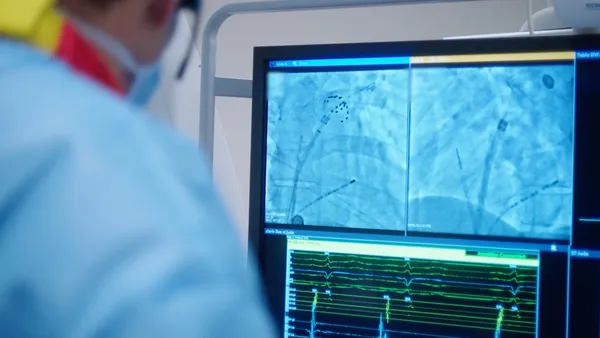Dive Brief:
-
Wearables maker iRhythm Technologies on Monday released data suggesting its Zio patch increased rate of atrial fibrillation detection and reduced cardiac events, in results presented at the American Heart Association's annual scientific meeting.
-
Wall Street analysts were broadly encouraged by the data, while cautioning that unlocking the market for asymptomatic patients will take time and likely require more clinical evidence to get payers on board. CVS' Aetna was among the backers of the trial, which tracked about 1,700 Aetna members at moderate risk for aFib.
-
The clinical trial is part of iRhythm’s effort to expand use of its patch to the asymptomatic population, thereby doubling its existing market. Linking Zio to more diagnoses and fewer deaths supports the effort.
Dive Insight:
Zio is a wearable heart monitor that connects to a data analytics platform. The platform provides a patient’s physician with details on multiple aspects of cardiovascular health, including atrial fibrillation. Today, iRhythm primarily targets the symptomatic population. By expanding into the high-risk asymptomatic population, iRhythm calculates it could access 10 million more patients.
To drive the expansion, iRhythm is running three clinical trials in asymptomatic patients. One of the trials, mSToPS, delivered data this week. The clinical trial hit key three-year endpoints.
Atrial fibrillation was newly diagnosed in 11.4% of subjects in the Zio cohort, compared to 7.7% in the control arm. The incidence rate of stroke, myocardial infarction, systemic embolism or death was 8.4 per 100 person-years in people diagnosed with atrial fibrillation in the Zio group. The figure for the control cohort was 13.8 per 100 person-years. That difference was statistically significant.
Other endpoints that favored Zio looked at hospitalizations. In the Zio active monitoring cohort, the rate of hospitalizations for bleeding was 0.32 per 100 person-years, versus 0.71 per 100 person-years in the control group. The rate of all-cause hospitalizations was lower in the Zio group, too.
Analysts at Baird, Needham, and William Blair framed the data as positive for iRhythm. However, they largely see the readout as a step on the long road to asymptotic sales, not a trigger for immediate change.
“Developing this opportunity is unlikely a flip of a switch, likely more of a grind, but directionally mSToPs hitting on the primary three-year clinical endpoint likely is sufficient to keep market development efforts moving forward,” analysts at Baird wrote in a note to investors.
Needham expressed similar sentiments, stating that iRhythm is likely to need more clinical data to unlock the asymptomatic opportunity. Economic data from mSToP are due next year. That update could help iRhythm prove its economic model, something the Needham analysts think needs to happen for it to penetrate the market, but results from the 52,000-subject GUARD-AF trial may be required to fully convince payers. GUARD-AF is due to complete enrollment by August.
Analysts at William Blair picked up on questions over the strength of the mSToPS data, noting that a 38% reduction in mortality was responsible for the success on the composite cardiac event endpoint. The stroke endpoint narrowly missed a significant reduction, the analysts said. However, that may be explained by the fact only some patients started on oral anticoagulants after diagnosis and to the William Blair analysts the stroke miss has a silver lining.
“For us the difference between the composite endpoint and the stroke endpoint, rather than being discouraging, is suggestive of important links between AF and other clinical conditions that could lead to death versus the most commonly referenced stroke risk of AF. As a result, we believe that there are several positive data points from mSToPS that can be leveraged for early market access wins,” the analysts wrote in a note to investors.
Shares in iRhythm traded down after the data drop but the company is still well up for the year. Driven by a jump after CMS included permanent codes for long-term electrocardiogram monitoring and recording in its draft Medicare physician fee schedule, the stock is up more than 250% this year.
Correction: An earlier version of this story mischaracterized when study results were shared. They were shared Monday.











